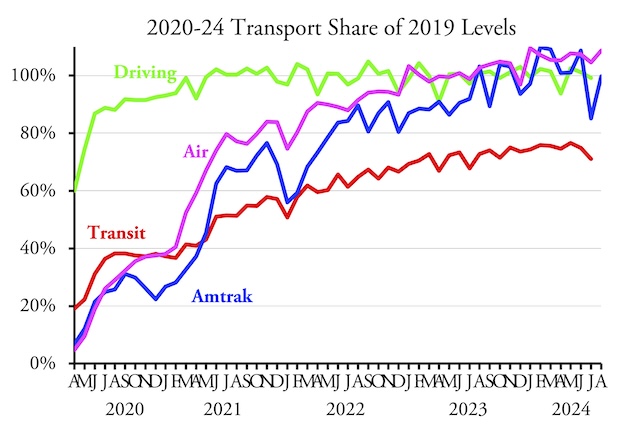Amtrak carried 99.7 percent as many passenger-miles in August 2024 as in the same month of 2019, according to the state-owned company’s monthly performance report. This was up from 85.1 percent in July. While Amtrak was still slightly short of pre-pandemic levels, domestic airline flights comfortably carried 8.7 percent more passengers in August 2024 than in 2019, according to TSA passenger counts.
The Department of Transportation has not yet posted August highway or transit data but when it does the results will be reported here.
While Amtrak numbers are in passenger-miles (which is the preferred measure) and airline numbers are in passenger counts, data from the Bureau of Transportation Statistics show that these follow one another fairly closely. In June, the most recent month for which such data are available, domestic flights carried 6.8 percent more passenger-miles than in June 2019.
It is also worth repeating that the airlines carry more than 100 times as many passenger-miles in domestic travel than Amtrak. When international air travel to or from the U.S. is included, it is more than 200 times.
Amtrak’s Northeast Corridor did well in August, carrying 17 percent more riders than in 2019. State-subsidized trains did poorly, carrying less than 94 percent of 2019. Long-distance trains did worst of all, carrying under 88 percent of 2019. It is possible that long-distance passenger-miles did better if people were taking longer trips than before the pandemic, but unfortunately Amtrak didn’t publish passenger-mile by route in 2019.









regarding HSR, which Amtrak Hopes to Become.
IF Tokyo-Osaka line made a profit, it wouldn’t really matter. If the T to O hsr route was the only one they made; so what. JNR profitability would have subsidized the line. If Japan had kept it’s trains to max of 120 mph over all servicability and financial capability of the line; BUT LABOR is also a key player. When JNR underwent it’s restructuring by 70s and 80s, timultuous circumstances including labor strikes, riots formed. In long run JNR bit the bullet and Laid off half it’s staff.
We saw this also in an industry Spain and US, solar industry; Green politicians love boast solar sector employs virtually as many people as the petro/gas industry; but thats’ issue; solar only producing barely 1% US total energy needs, a workforce of 600,000 is huge labor cost compared to one that produces 70-80% nations energy; the Solar and wind industry cannot grow without enormous labor costs. And automation is difficult because it’s all left outside to same environmental conditions.
MODAL transport share in Japan, rail ridership remained fairly same in tokyo metro area, except for Buses which lost half their ridership from 14% to 6% by 2003.
Outside Japan’s three largest urban areas, it declined from 32% to just 8. Rail ate into cheap buses.
Buses can be made luxurious and US and Japan demonstrate both. They also require None massive upfront costs or infrastructure concerns. That 200 Billion in rail infrastructure could have been better spent on water/power/modern fiber and Earthquake proofing old buildings, more public housing.
Paris wastes billions building ugly bike lanes that inconvenience drivers and which hardly anyone uses (measured by passenger miles, the preferred measure):
https://momentummag.com/paris-cycling-numbers-double/
AP, could you take a quick trip to Vietnam like you did recently with Japan? Hopefully you can talk them out of this mad plan to build obsolete technology they are pursuing:
https://www.businesstimes.com.sg/international/asean/vietnam-plans-us67-billion-high-speed-railway-no-foreign-capital
Even worse, it’s going to connect to China’s high-speed rail network 🙁 Sounds like a huge waste of money that no one will use.